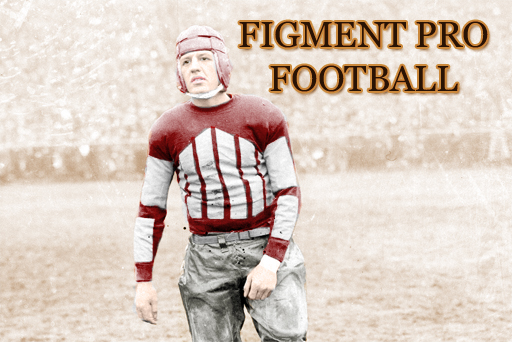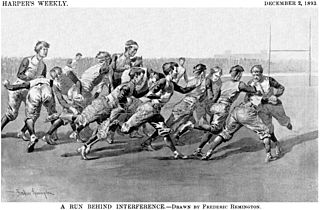Like other professional sports, the rise of the professional flavor of American football emerged from the popularity the amateur version of the game (college football in this case) and the formation of "athletic clubs" which fueled betting, which in turn fueled the importance of winning and losing, and that in turn fueled a desire to find the best practitioners of the sport. And in true American fashion those practitioners (aka players), as the possessors of a commodity that was in demand, would naturally seek compensation for that commodity. So professional football, like baseball and hockey before it, and basketball afterwards, was born from the simple and common desire to make some money.
Without getting bogged down in the myriad names, athletic clubs and associations and various teams that dotted the "professional" football landscape in the 19th century, a brief synopsis of the serpentine manner in which an organized (key term, there) professional league was founded.
In the late 19th century college football became popular - not as popular as baseball, mind you, but particularly in the East and Midwest, college football had a devoted, and growing following in the 1880s and '90s. Somewhat interestingly, the first openly professional league was formed by, of all people, two baseball clubs. At the height of the "baseball war" of 1890-91, the clubs in Philadelphia: the Keystones of the Century League and the Sailors of the Border Association, had a strong rivalry for the hearts & minds of Philadelphia fans. So when it was discovered that Keystones owner Jefferson Edgerton was going to field a professional football club, it was only natural that Sailors owner Victory Crary would try to one-up Edgerton with a club of his own. The personal enmity of Edgerton & Crary made this story a colorful one that we do not have the time to explore in full here. However, at this time, a vibrant semi-professional scene could be found in western Pennsylvania and Ohio - this was the epicenter of the pro game (such as it was) at the time. Crary, in his typical fashion, was determined to put one over on Edgerton and got together with a club owner in Allegany (now part of the city of Pittsburgh) and another in Youngstown, and created a short-lived "league" composed of three clubs (Crary's club naturally used the Sailors moniker). The "Border Football Association" lasted one season (which consisted of just four games) and lost money but it did earn the nod as the first professional football circuit.
Similar to what was happening in Canada with hockey, the amateur variety of football (college football in this case) was openly disdainful of professionalism. This didn't necessarily prevent some college teams from playing the various athletic clubs sprinkled throughout Pennsylvania, Ohio and Michigan who were paying players in what was basically an open secret. But the more powerful voices in the collegiate games, coaches in particular, were openly scornful of professionals, adhering to an increasingly outmoded mindset that amateur sports were "pure" - even when some of them were later found to have employed paid ringers for big games.
The AIAA expressly forbid professionals of any stripe from participating. This led to cases like the one of "Buck Barnwell" at Nobel Jones. Barnwell was in fact Joseph Barrell, a professional boxer who would go on to become one of pro football's pioneers, but at the time could only play under an assumed name, even as his real identity was well known around the Nobel Jones campus. Barnwell/Barrell was not the only case of this type. But publicly - and loudly - the top voices in the collegiate game were very much anti-professionalism in football. To be fair to Barrell, he was not paid to play at Nobel Jones - he was instead given a scholarship, which was at the time a still somewhat novel invention that is now ubiquitous.
In the early years of the 20th century, pro football took on a more circus-like mien with the rise of barnstorming clubs. With no official league or association to govern the game, these barnstorming clubs would tour the eastern half of the country throughout the fall, playing a variety of opponents that included other barnstormers, local athletic clubs and even on some occasions, a collegiate team. Based largely in the hotbeds of Pennsylvania, Ohio and later Michigan, Indiana and Illinois, these clubs played everywhere between Kansas City and Boston and served as proof that professional football could be a viable business.
The barnstorming era came to a close in the fall of 1920. The story is somewhat well-known by now: a group of men representing four existing and three would-be professional football clubs met at a shuttered tavern named "Bubby's" in Fort Wayne, Indiana in August of 1920. From this meeting would be born the American Football Association. That first meeting included Carl Boon and Joe Barrell (of "Buck Barnwell" fame) who were forming a club to play in Chicago (a plum location to be sure), Jack Kristich (owner of "Bubby's" who would run a club in his native Fort Wayne), and Alfred Trumaine (who was to run a club in Pittsburgh, but who dropped out to take a college coaching job - he was later replaced by John Oxendine) representing the "paper clubs" who hadn't yet been formed. The barnstormers were represented by Akron's Edward Cheatham, Cleveland's Walter Finch, Dayton's Paul Sanders and Youngstown's Norbert Underwood. The seven groups hammered out the barest details for their fledgling circuit, most of which centered around three main tenets: a strict playing schedule, an agreement to not poach players or use collegians (a move designed to mollify the college coaches) and a membership fee of $100. Considering the billion-dollar price tag of a modern club, this was quite a bargain.
A second meeting followed the first, again at "Bubby's" where the AFA was officially named (they had forgotten to do so at the original meeting) with three additional clubs added, giving the AFA a nice, round ten-club membership for its fledgling season. The group was unable to secure a club for Detroit, which had been one of their goals, but they did add two clubs in New York (Buffalo and Rochester) and another in Ohio (Columbus), the most heavily represented state and, at the time, the biggest hotbed for the pro sport. Seven of the ten clubs were barnstorming veterans and had rosters that were solid. Two of the three new clubs - Chicago and Pittsburgh - were run by players (Boon & Barrell and Oxendine respectively) and were able to recruit top talent. Fort Wayne's Kristich was not a player, but had strong ties through Boon and he too was able to put together a relatively competitive club on short notice.
Pro Football was off and running.

